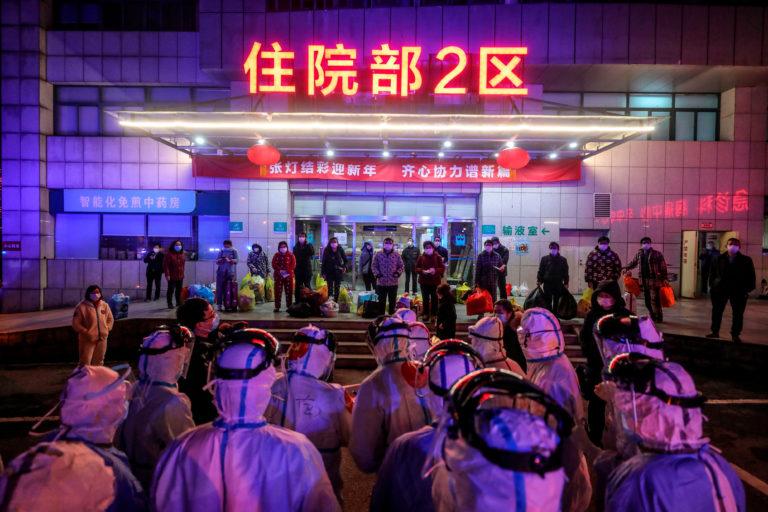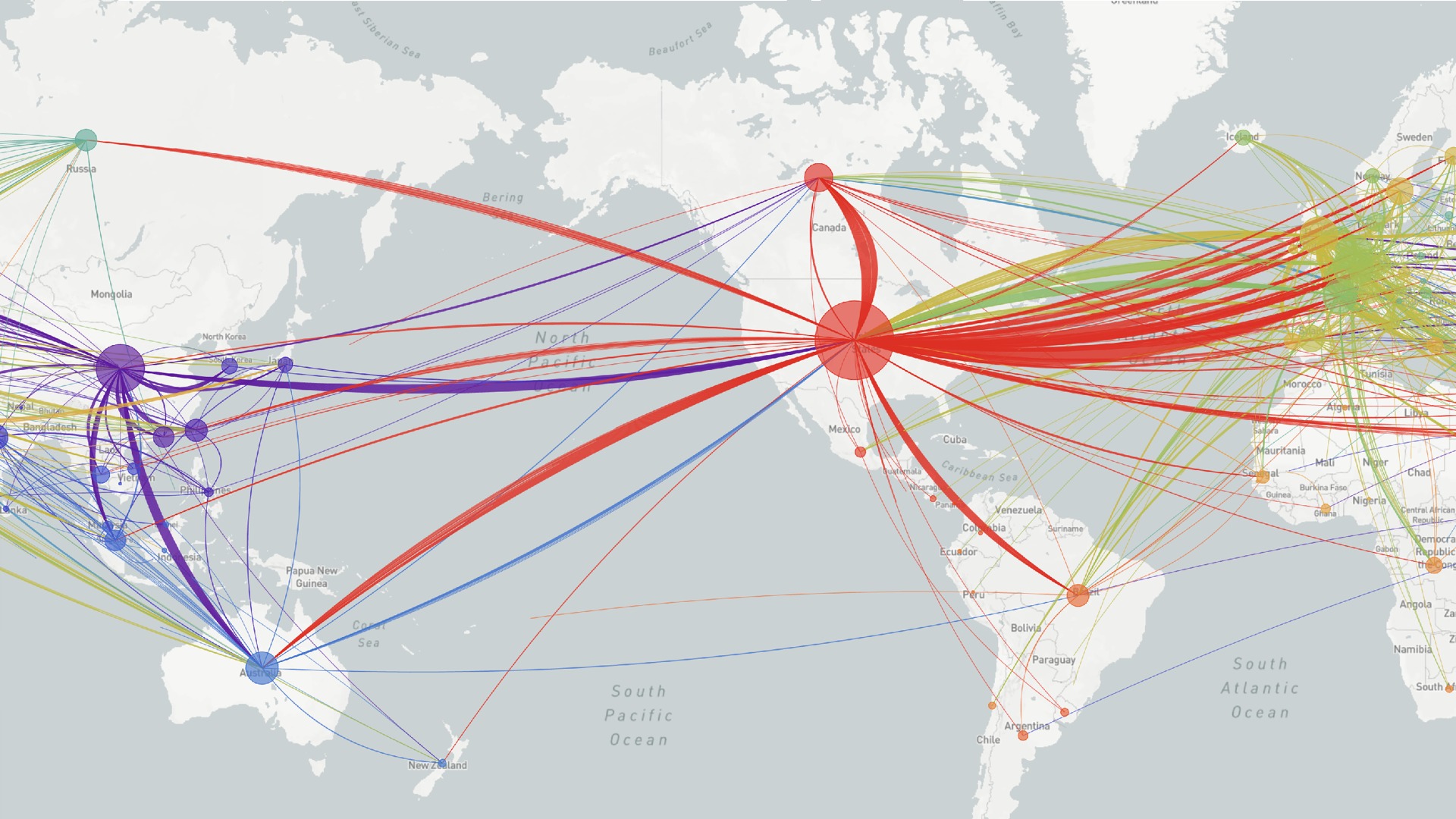Footprints of the coronavirus: How it came to Canada and went around the world
Terry Glavin: Genome samples reveal the pathogen’s deadly journey, and unlike the leaders of certain global superpowers, the science doesn’t lie.

Patients infected with COVID-19 wait to be transferred from Wuhan No. 5 Hospital to the newly-built Leishenshan Hospital in Wuhan, China on March 3, 2020 (AFP/Getty Images)
Share
The creature that singles out the old and the infirm and sickens and kills people with the disease COVID-19 is a species of the genus betacoronavirus, an ancient thing descended from a distant ancestor that emerged roughly 10,000 years ago in the realm of Riboviria, in the order Nidovirales.
It comes from the family of the Coronaviridae, and the subfamily Orthocoronavirinae, and it is important to understand something of the science involved in its taxonomy to fully appreciate the reasons why most of the world’s advanced economies ended up in a state of suspended animation, and why roughly half the world’s people, or 3.9 billion of us, by April, were still following instructions to more or less hide from the beast and wait for some kind of all-clear signal.
Ever since Jan. 5, when a “wet market” in the metropolis of Wuhan in central China was implicated in the World Health Organization’s first bulletin reporting a “pneumonia of unknown etiology” in that city, it’s always the same. In every guidance from the WHO and every declaration from the People’s Republic of China, in all the strange prescriptions from Donald Trump’s White House and in each of the earnest rationales issued by Justin Trudeau’s government in Ottawa, we are always exhorted to heed “the science.”
READ MORE: The doomed 30-year battle to stop a pandemic
But the science tells its own story. It tracks the creature’s genetic footprints across the face of the earth, and its arrival and diffusion in Canada, without the aid of a teleprompter or speaking notes. The story offers no heroic role to Health Minister Patty Hajdu, and it is of no particular use to the Trudeau government’s justifications for waiting until March 18 before shuttering the international arrivals sections at most of Canada’s airports. Neither does it offer any special comfort to those among Ottawa’s critics who wanted all direct flights from China shut down weeks before that.
An important early chapter in the story the science tells revolves around molecular-clock analyses that illuminate the way that several species of the genus betacoronavirus have been thriving in the bloodstream of various kinds of bats for the past 5,100 years or so. But the main chapter opens when the betacoronavirus species SARS-CoV-2 revealed itself to Chinese geneticists on Jan. 7, 2020, confirming what a group of especially brave whistle-blowers in Wuhan had been warning about for weeks. So we’ll start there.
***
The doctors who had attempted to alert their peers about the presence of a deadly coronavirus showing up in hospital patients were disciplined and ordered to say nothing. A week before Jan. 7, on New Year’s Day, eight doctors were punished for “rumour-mongering.” Among them was Li Wenliang, the 34-year-old doctor at Wuhan Central Hospital whose death a month later, from complications arising from COVID-19, has made him a folk hero in China.
For weeks, Beijing and the WHO had insisted that there was no obvious evidence that the coronavirus was readily capable of “human-to-human” transmission, even though front-line doctors were warning that it was spreading by human contagion from the beginning. From the earliest days of the outbreak, the gravity of the crisis in Wuhan was not communicated to the outside world by the WHO. The situation became known to the world only because of reports that found their way through China’s vast and elaborate surveillance and censorship apparatus.
Either because of the supine leadership of the WHO’s director-general, Tedros Adhanom Ghebreyesus, or more charitably, because the United Nations agency he leads is constitutionally incapable of behaving any other way, the WHO aided and abetted the Chinese government in its disinformation, its denials and dismissal of the severity of the catastrophe unfolding in Wuhan. So we need to get that out of the way.
RELATED: Coronavirus in Canada: These charts show how our fight to ‘flatten the curve’ is going
Here’s the WHO, repeating almost word for word the party line in Beijing, on Jan. 14: “Preliminary investigations conducted by the Chinese authorities have found no clear evidence of human-to-human transmission of the novel coronavirus.” But here’s an internal Chinese National Health Commission memo leaked to the Associated Press, quoting commission head Ma Xiaowei, from the same day, Jan. 14: “The epidemic situation is still severe and complex, the most severe challenge since SARS in 2003, and is likely to develop into a major public health event.”
In the 2003 severe acute respiratory syndrome pandemic, Chinese health authorities didn’t bother to inform the WHO about the initial outbreak for nearly three months. It went on to sicken more than 8,000 people around the world, killing 774 of them. In Canada, Toronto was particularly badly hit, with 251 cases and 44 deaths. An April 2003 WHO travel advisory urging people to stay away from Toronto lasted only a week, but a later inquiry determined that its lingering impact on tourism and travel took $950 million out of the economy.
Because of that history, there was a heightened sensitivity at the WHO in Geneva, and around the Chinese Communist Party’s politburo in Beijing, about a SARS-like pandemic erupting again, in China. Nevertheless, it wasn’t until Jan. 20—about a month after Wuhan hospital staff first warned that human-to-human transmission of a SARS-like virus was occurring—that Beijing changed its story and admitted to the world that it was true.
During those critical first weeks, the laboratories in Wuhan and Shanghai that had sequenced the virus and discovered its close relationship to SARS-CoV-1 (the SARS from 2003) were told to hand over their samples or destroy them and otherwise keep quiet. The Shanghai laboratory where researchers published the world’s first genome sequence of the deadly thing that causes COVID-19 was shut down the very next day.
But by formally isolating the species SARS-CoV-2 as the pathogen involved in that pneumonia of unknown cause that was causing people to get sick in Wuhan, the whistle-blowers were vindicated. The story science tells confirmed their own observations and their own stories. It was true: The thing that was causing people to fall so deathly ill, and that seemed so very much like the SARS virus that made its first appearance in Guangdong in southern China in November 2002, turned out to be such a close cousin of SARS-CoV-1 that it shared roughly 80 per cent of its genetic structure.
RELATED: China was in violation of International Health Regulations. What do we do now?
By 2004, Chinese scientists had concluded that the SARS-CoV-1 virus originated in horseshoe bats that roost in a cave in Yunnan province and had mutated and infected people through intermediary transmission via a ferocious little forest mammal called a civet, which is a bit like a cross between a mongoose and a cat. Civets have long been mainstays in many Chinese “wet” markets.
So where did SARS-CoV-2 come from?
***
On New Year’s Eve, just a week before SARS-CoV-2 was identified, the WHO’s China office was informed by local health authorities that 41 patients were suffering from a mysterious ailment in Wuhan, the capital of Hubei province, and they were being closely monitored, and what connected most of them was that they were known to have frequented a live animal and seafood market in the city’s Jianghan district.
The Huanan Seafood Market was shut down and subjected to a thorough disinfection and environmental sanitation on New Year’s Day. This did not serve the purpose of preserving evidence. In any case, more than a dozen of the original 41 patients had been nowhere near the market, and hadn’t been in contact with anyone who had been. The first person known to have become sick from the new coronavirus, identified only as Patient Chen, reported no connection to the market whatsoever. He was diagnosed on Dec. 8. He recovered.
There has been some evidence from U.S intelligence agencies, and some reasonable speculation among scientists who study viruses, that SARS-CoV-2 might have inadvertently escaped from the Wuhan Institute of Virology, a world-renowned research centre not far from the wet market in the Jianghan district. There has also been some profoundly unhelpful speculation that the virus was some sort of genetically engineered biological weapon the Wuhan institute was working on. This is a conspiracy-theory hypothesis that geneticists have quite conclusively disproved.
Another theory that made the rounds was that SARS-CoV-2’s initial transmission from horseshoe bats to people occurred through the intermediary of a pangolin, a critically endangered scaled mammal that looks like a tiny anteater. Malayan pangolins are known to carry a bat-origin coronavirus very much like SARS-CoV-2. Highly prized on the black market of wild animals owing to their tasty meat and the reputedly magical properties of their scales, the pangolins’ absence on any vendors’ lists at the Huanan market was explained away by the fact that, in China, it’s illegal to sell them.
But this is just where the unanswered questions begin.
All these months later, with the Chinese economy back up and running and the rest of the world on its knees, the origin of SARS-CoV-2 is just one of the things nobody knows. Despite the best collaborative efforts of scientists in China and around the world, we still don’t know exactly how this new species of betacoronavirus ended up in human beings in the first place.

There remains a single, unmovable obstruction standing in the way of a rational, science-based understanding of how everything went so badly off the rails. It’s this: The increasingly bellicose regime of Chinese supreme leader Xi Jinping doesn’t want the world asking its own questions about what happened. Beijing’s foreign ministry has been explicit about that, threatening repercussions in response to calls for an independent inquiry.
Xi’s diplomats and ambassadors, the Chinese Communist Party’s propaganda platforms and several official foreign ministry statements have thrown up a dizzying variety of easily refutable falsehoods, misdirections and strange insinuations, ever since the virus outbreak came to the world’s attention in early January. The virus was smuggled into Wuhan by the U.S. military; the outbreak began in Italy and not in China at all; and (this one hung around until well into February), the virus was far less a public health concern than “the U.S. flu.” That kind of thing.
The European Union’s external affairs office has taken notice of this, in a report that enraged Beijing—even though European sensitivity about Beijing’s response appears to have caused EU officials to water down the report. Still, the report concludes that both Russia and China “have continued to widely target conspiracy narratives and disinformation both at public audiences in the EU and the wider neighbourhood.”
While Chinese scientists have taken pains to collaborate with colleagues from universities and government institutions in the West, by April, the Chinese ministry of education had begun to insist on vetting research papers before their publication in academic journals. Studies on the origin of SARS-CoV-2 were to be subjected to special scrutiny.
Beijing has also loudly opposed the idea of an independent and impartial inquiry aimed at finding answers to some of the most basic questions that should have been readily answerable by now. Among those questions, these two stand out: How was it that the pandemic spread with such ease and rapidity throughout the world? Why couldn’t we see what was coming?
READ MORE: The coronavirus pandemic is the breakthrough Xi Jinping has been waiting for
Here’s how the pandemic spread.
Every day, tens of thousands of travellers leave China on international flights to the four corners of the earth. After the National Health Commission’s Jan. 20 admission that the SARS-like virus in Wuhan was transmissible by human contagion, five million people were allowed to leave Wuhan. The prefecture of Wuhan was not locked down until Jan. 23.
What the science says about the journeys SARS-CoV-2 embarked upon, and the various routes it took from Wuhan to find its way around the world, is a story told most accurately in the form of data accumulated and updated daily by GISAID, a public-private partnership based in Munich, hosted by the German government.
Initially launched in response to the deadly “bird flu” H5N1 that broke out across the world in 2003, the GISAID data, obtained from SARS-CoV-2 genome samples contributed by laboratories around the world, is presented most vividly by scientists and technicians working with an open-source scientific collaboration known as Nextstrain. The Nextstrain data project began with a handful of virus samples and ended up sampling 4,115 genomes between December and April.
What the data shows is a surprising story of several routes the SARS-CoV-2 took in sequence, sometimes showing up in a particular country once, directly from China, or several times. Sometimes, SARS-CoV-2 shows up after having made one, two or more stops along the way.
For countries like Taiwan, New Zealand and South Korea, SARS-CoV-2’s footprints come to a fairly abrupt end in the country, usually as soon as they show up. In badly hit countries, like Italy, SARS-CoV-2 arrived several times, directly and indirectly. The epicentre of the crisis in the United States is New York, where almost all of the SARS-CoV-2 arrivals were from Europe, after having arrived in Europe in travellers who had been in China, or had been in contact with travellers from China.

In Canada’s case, the first handful came from China and Iran, but almost from the outset, SARS-CoV-2 was also coming in via the United States. The overwhelming number of travellers who ended up bringing the virus into Canada carried it through the U.S. It wasn’t until March 24, about a week after Ottawa more or less shut down all international arrivals, that “community transmission” was the predominant cause of infection in Canada.
The story the science tells is not kind to Justin Trudeau’s government—not so much for keeping Canada’s borders open long after most developed countries had closed theirs, but for imposing a variety of awkwardly implemented airport screening measures that several scientific studies had assessed as largely useless—including an important study co-authored by Dr. Theresa Tam, Canada’s chief public health officer.
But the science most brutally disfavours the several denials and disinformation “narratives” circulated by Chinese authorities, along with the WHO’s several repeated admonitions against travel bans and against “stigmatizing” China. If you follow all the genetic footprints SARS-CoV-2 left behind, backwards, they all lead back to Wuhan.
So, why couldn’t we see it coming?
On April 20, International Development Minister Karina Gould released a read-out of a conversation she’d had with WHO director-general Tedros, indicating they had both agreed there was a “critical need” for a review of the WHO’s handling of the pandemic. But such reviews are standard operating procedure for the WHO, and it’s unlikely a run-of-the-mill internal review would shed much light on the question.
The Trump White House temporary suspended U.S. contributions to the WHO pending a review of the agency’s controversial deference to Beijing’s consistently implausible account of events. But apart from Canada, even those U.S. allies that opposed Trump’s move are sharply critical of the WHO’s handling of the pandemic and of Beijing’s suppression of information about the events in Wuhan.
RELATED: Has coronavirus made us part with our online privacy?
After a conference call among G7 ministers in April, British Foreign Secretary Dominic Raab told reporters the U.K. will want a “deep dive” investigation into the causes of the pandemic and how it got out of control in Wuhan. “I don’t think we can flinch from that at all, it needs to be driven by the science,” Raab said. Britain can’t go back to “business as usual” with China after what has happened, he added.
Australian Prime Minister Scott Morrison said he intends to push for an independent investigation among other UN member states at the World Health Assembly, the decision-making body that oversees the WHO. In response, China’s ambassador to Australia threatened a boycott of Australian wine exports and difficulties for Australia’s beef industry, as well as the spectre of a Chinese tourist boycott.
Even in the absence of a proper inquiry, the already known facts tell a compelling, damning story.
In the weeks leading up to Beijing’s Jan. 20 admission that the dangerous new virus in Wuhan was contagious between people, two major provincial Communist Party gatherings were allowed to go ahead in Wuhan and Hubei. Party officials in Wuhan prefecture convened its massive annual Jan. 18 Lunar New Year banquet, attended by tens of thousands of people, two days before Beijing announced what it had known for weeks: The virus that came to be called SARS-CoV-2 was readily capable of spreading between people.
By Jan. 20, the beast had already been loosed upon the world. That very day, the United States reported its first case to the WHO. So did South Korea. Hundreds of people with the telltale symptoms of the new coronavirus illness were already showing up at emergency departments across Hubei province and elsewhere in China. On Jan. 10, the first death in China was officially confirmed. A 61-year-old man from the Huanan market cluster.